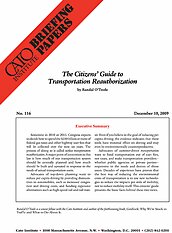Advocates of top-down planning want to reduce per capita driving by providing disincentives to automobiles, such as increased congestion and driving costs, and funding expensive alternatives such as high-speed rail and rail transit. Even if you believe in the goal of reducing per capita driving, the evidence indicates that these tools have minimal effect on driving and may even be environmentally counterproductive.
Advocates of customer-driven transportation want to fund transportation out of user fees, not taxes, and make transportation providers— whether public agencies or private parties— responsive to the needs and desires of those users. Decades of experience have proven that the best way of reducing the environmental costs of transportation is to use new technologies to reduce the impacts per mile of mobility, not to reduce mobility itself. This citizens’ guide presents the basic facts behind these two views.


